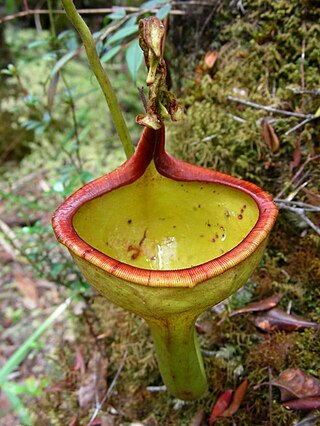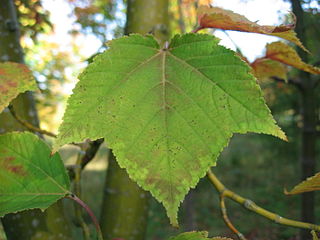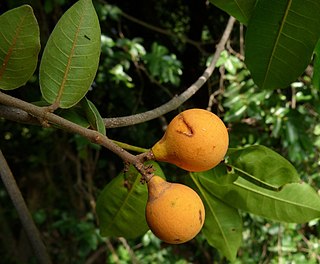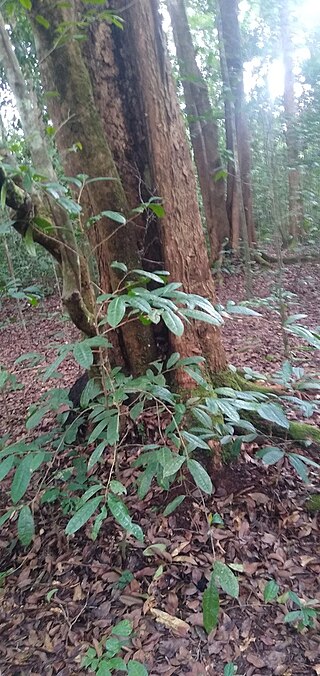Androstachys johnsonii, the Lebombo ironwood, is a medium-sized Afrotropical tree species, and the sole member of the genus Androstachys in the Picrodendraceae. It is slow-growing, evergreen to deciduous, and dioecious, with flowers that are wind-pollinated. It is native to southeastern Africa and Madagascar, where it generally occurs gregariously on rocky hillsides, particularly in hot and dry situations. It produces a hard, durable wood which is of economic interest. Its specific name commemorates W. H. Johnson, a 19th-century Director of Agriculture in Mozambique. Four related species which are native to Madagascar, are usually placed in genus Stachyandra.

Nepenthes eymae is a tropical pitcher plant endemic to Sulawesi in Indonesia, where it grows at elevations of 1,000–2,000 m (3,300–6,600 ft) above sea level. It is very closely related to N. maxima, from which it differs in its wine glass-shaped upper pitchers.

Nepenthes izumiae is a tropical pitcher plant endemic to Sumatra, where it grows in montane forest at 1700–1900 m above sea level. It appears to be most closely related to N. lingulata and N. singalana.

Nepenthes surigaoensis is a tropical pitcher plant endemic to the Philippine island of Mindanao, where it grows at elevations of at least 800–1200 m above sea level.

Acer rufinerve, the grey-budded snake-bark-maple, redvein maple or Honshū maple, is a species of tree in the snakebark maple group, related to Acer capillipes. It is native to mountain forests of Japan, on Honshū, Kyūshū and Shikoku.

Shorea leprosula is a species of tree in the family Dipterocarpaceae. It is native to Sumatra, Borneo, Peninsular Malaysia, Java, and Thailand.

Guilandina bonduc, commonly known as grey nicker, nicker bean, fever nut or knicker nut, is a species of flowering plant in the senna tribe, Caesalpinieae, that has a pantropical distribution. It is a liana that reaches a length of 6 m (20 ft) or more and scrambles over other vegetation. The stems are covered in curved spines. Its 2 cm (0.8 in) grey seeds, known as nickernuts, are buoyant and durable enough to be dispersed by ocean currents.

Celtis africana, the white stinkwood, is a deciduous tree in the family Cannabaceae. Its habit ranges from a tall tree in forest to a medium-sized tree in bushveld and open country, and a shrub on rocky soil. It occurs in Yemen and over large parts of Africa south of the Sahara. It is a common tree in the south and east of southern Africa, where the odour given off by freshly-cut green timber is similar to that of Ocotea bullata or black stinkwood.

Parinari excelsa, the Guinea plum, is a species of large, evergreen tree in the family Chrysobalanaceae. It has a very wide distribution in tropical Africa and the Americas. This species grows to 50 m (160 ft) tall while the trunk is up to 1.5 m (5 ft) in diameter.

Ceriops tagal, commonly known as spurred mangrove or Indian mangrove, is a mangrove tree species in the family Rhizophoraceae. It is a protected tree in South Africa. The specific epithet tagal is a plant name from the Tagalog language.

Dysoxylum arborescens, commonly known in Australia as Mossman mahogany, is a small tree in the mahogany family Meliaceae. It is native to rainforests of Malesia, Papuasia, Queensland and nearby islands.

Dysoxylum parasiticum, commonly known as yellow mahogany, is a species of rainforest tree in the family Meliaceae native to Taiwan, parts of Malesia, Papuasia, and northeast Queensland.

Strychnos camptoneura is a species of plant in the Loganiaceae family. It is native to Camaroon, the Central African Republic, the Democratic Republic of the Congo, Gabon, Ivory Coast, Liberia, Nigeria, the Republic of the Congo and Zaire.
Osodendron altissimum, formerly known as Albizia altissima, is a low branching tree within the Fabaceae family, it grows along river banks in the Lower and Upper Guinean and Congolian forests of west and central Africa.
Cynometra ananta is a perennial large tree within the Fabaceae family. Its timber is traded under the name Apome in Ivory Coast and Ananta in Ghana.

Landolphia heudelotii is a climbing shrub or liana that is within the Apocynaceae family, it occurs in the Guinea and Sudan savannahs of West Africa and cultivated for its rubber and edible fruit.
Landolphia angustisepala is a species within the Apocynaceae family. It occurs in Gabon and the Democratic Republic of the Congo.
Landolphia buchananii is a liana within the Apocynaceae family. It is sometimes called Nandi rubber in English and known locally as Mugu among Kikuyus. Occurs in savannahs and montane forests in East Africa and Southeastern Nigeria.
Landolphia dulcis is a climbing shrub or liana within the Apocynaceae family.

Sacoglottis gabonensis, commonly known as bitterbark tree or cherry mahogany is a medium to large sized evergreen tree within the Humiriaceae family. It is the only species within the genus, Sacoglottis that is native to tropical Africa, another, guianensis Benth. being native to Amazonia. It occurs in rainforests or on sandy soils of Senegal eastwards to Angola in central Africa. It is traded locally and known in some countries under the name Ozouga.













